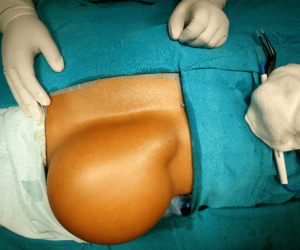

Cureus has retracted a 2024 case study after learning it had published a piece about the identical patient, by authors from the same institution, just months earlier.
The paper, “Lipoma Growing on the Back for 26 Years: A Bizarre Case Report,” was published March 26 and retracted June 17. Three of the four authors are affiliated with Datta Meghe Institute of Higher Education and Research, in Wardha, India. The corresponding author, Samiksha V. Gupta, was a medical student at the institution but has since received his degree.
The notice states:
This article has been retracted by the Editor-in-Chief after it has been discovered that this case was already presented and published in Kher C, Chakole S (January 26, 2024) Giant Lipoma: A Case Report. Cureus 16(1): e53000. doi:10.7759/cureus.53000.
“It was discovered” is doing a lot of work here.
We asked Springer Nature, which now owns Cureus, how the editors of the journal managed to publish the case study twice, given the distinctive topic and the fact the authors came from the same institution – Datta Meghe Institute of Medical Sciences.
Graham Parker-Finger, director of publishing and customer success for Cureus, told us:
We understand that the assistant surgeon on the case shared details with physicians who cared for the patient post-op without realizing that the attending physicians were going to publish this case. As a result, the case was submitted and published twice. Both papers went through the review process and the overlap was not identified at the time as the case was written up by two different groups and thus there was no text overlap/duplication flagged by ithenticate. Additionally, although of the same subject, the photos are different. As soon as we became aware of the issue, we investigated, leading to the retraction of the later report.
In fact, the photos of the tumor, which are available online, are not so very different after all. The only apparent difference is that the colors are more vivid in the retracted image, which also is rotated 90 degrees counter-clockwise. (The caption on one of the images reads: “A swelling of 10 cm × 12 cm x 7 cm was present over the left scapula;” the other “depicts a giant lipoma over the right suprascapular region” – which clearly is incorrect.) The articles also show the tumors after removal, and again, they are obviously identical.
We asked Parker-Finger if the episode has prompted any changes in process at the publication. He told us:
The articles were submitted 12 weeks apart with different authors and, as they were written independently, did not contain textual similarities that would be picked up by ithenticate, so identifying the overlap was not possible. It may be worth noting that we receive more than a thousand submissions each week.
We asked Gupta about the duplicate submission, and why he and his colleagues chose Cureus as a home for the paper:
I sincerely apologize for any confusion caused by the submission of the case. To clarify, I was not aware that my colleagues at Datta Meghe had already submitted the case for publication.
Regarding your question about why Cureus was chosen over other journals, our decision was based on several factors. Cureus was selected because we believed it offered a suitable platform for the dissemination of our research findings, aligning well with the scope and objectives of our work.
I understand the importance of addressing this issue promptly.
We were, well, curious how Gupta’s group got the image for their paper. He said:
I actually reached out to my senior for assistance, and he provided me with all the information and pictures related to that particular case.
Like Retraction Watch? You can make a tax-deductible contribution to support our work, subscribe to our free daily digest or paid weekly update, follow us on Twitter, like us on Facebook, or add us to your RSS reader. If you find a retraction that’s not in The Retraction Watch Database, you can let us know here. For comments or feedback, email us at [email protected].
Both groups broke publication rules (i.e., cheating), both papers should be retracted for this reason
Submission declaration:
“I, the Corresponding Author, declare that this manuscript is original, has not been published before and is not currently being considered for publication elsewhere.”
Well, if the story which the authors tell is true (and it at least makes sense), the _manuscripts_ were original, having been written entirely independently. The science on the other hand was not for the second one.
That situation actually is quite common in fields where data are public (either immediately or after some delay) and can be analyzed by multiple groups at more or less the same time, each unaware that someone at the other end of the Earth is doing it as well.